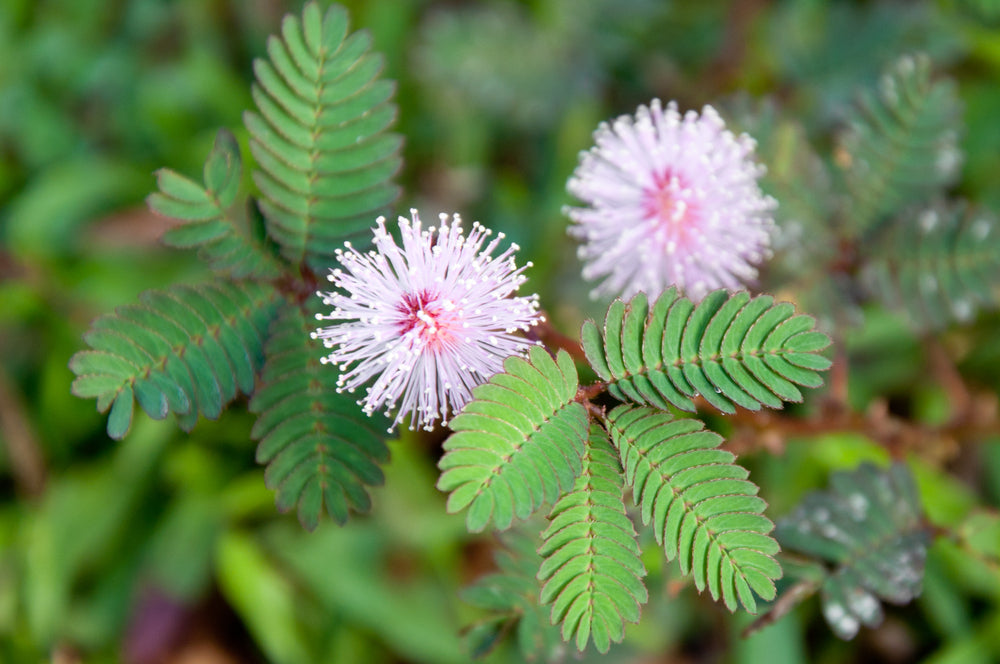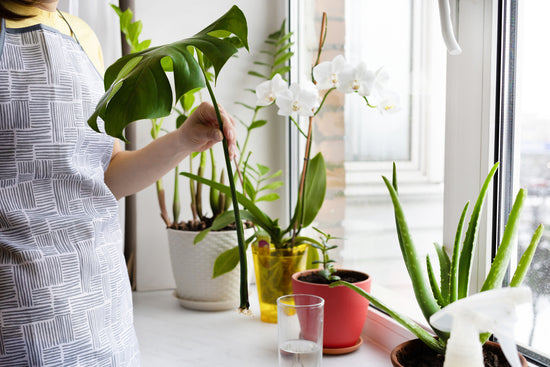Mimosa pudica, commonly known as the Touch-Me-Not plant, mimosa, Dormidera plant or Shameplant, is a fascinating and unique species that belongs to the Pea family (Fabaceae). Native to South and Central America, it has gained global popularity for its intriguing response to touch.
• Types of Mimosa Plants
There are only two types of Mimosas - there is a smaller version and another, quite big one.
-
Mimosa Pudica Plant:
The most well-known variety, recognized for its touch sensitivity.
-
Mimosa Pigra Plant:
Also known as the Giant Sensitive Plant, it's a larger species native to Central and South America.
• Mimosa Plant Characteristics

-
Touch Sensitivity of the Dormidera Plant:
Mimosa pudica's most distinctive feature is its rapid response to touch. When touched, the leaflets fold inward and droop, a phenomenon known as thigmonasty. This defensive mechanism is thought to discourage herbivores by making the plant less appealing or accessible.
-
Leaf Structure:
The leaves of Mimosa pudica are finely divided and resemble fern fronds, this adds to the plant's overall delicate and ornamental appearance.
The leaflets are typically a vibrant green, providing a visually appealing contrast to the pink or purple flowers.
-
The Dormidera Plant Grows Flowers...
...but not really. Mimosa pudica produces small, spherical flower heads that resemble puffballs. These flowers are composed of numerous tiny pink or purple tubular florets.
The flowers are arranged in globose clusters at the end of the stems, creating a visually striking display.
-
Growth Habit:
Mimosa pudica is a low-growing, forming a mat-like ground cover. It grows as one of the best creeper plants with creeping stems sprawl along the ground, creating a lush and attractive carpet.
The plant exhibits a branching pattern with stems radiating from a central point, contributing to its spreading growth habit.
Buy Creeper Plants online
-
Dormidera Plant Seed Characteristics:
Mimosa pudica seeds are coated with a mucilage, a gelatinous substance that expands upon contact with water. This adaptation aids in seed dispersal and protection, as the mucilage may deter predators.
-
Environmental Adaptations:

The Mimosa pudica is a sensitive plant and thrives in bright, indirect sunlight but can adapt to partial shade. This adaptability makes it suitable for various garden environments.
The plant exhibits wilting in response to touch, but this reaction is temporary and not a sign of drought stress. It helps the plant conserve water by reducing surface area exposed to sunlight temporarily.
-
Reproductive Strategy:
Mimosa pudica's flowers exhibit a form of floral mimicry, resembling larger flowers to attract pollinators. The plant relies on insects for pollination, contributing to its reproductive success.
-
Seasonal Behavior:
Even as a sensitive plant , depending on the climate, Mimosa pudica can behave as an annual or perennial. In colder climates, it may act as an annual, while in warmer regions, it can persist as a perennial.
• Mimosa Pudica Uses
There are countless Mimosa Pudica benefits which make this plant not just alluring because of its mystique and shyness, but also a brilliant addition to gardens everywhere as a medicinal plant.

1. Mimosa Pudica Medicinal Uses
-
Anti-inflammatory Properties:
Touch me nots have been traditionally used for their anti-inflammatory effects. The plant contains compounds that may help alleviate inflammation in the body.
-
Wound Healing:
The leaves of Mimosa pudica are believed to have wound-healing properties. They can be crushed and applied topically to minor cuts and wounds.
-
Antimicrobial Activity:
Compounds found in Mimosa pudica have demonstrated antibacterial and antifungal activities. This suggests potential benefits in combating various microbial infections.
2. Skin Health
-
Mimosa Pudica Dermatological Uses:
In traditional medicine, Mimosa pudica has been used for skin conditions. The anti-inflammatory and antimicrobial properties may contribute to its effectiveness in managing certain skin issues.
-
Neuroprotective Potential:

The plant contains antioxidants that may help protect nerve cells from oxidative stress. Research suggests potential neuroprotective effects, but further studies are needed.
3. Mimosa Pudica Seed Benefits
The mucilaginous coating on Mimosa pudica seeds expands when in contact with water, aiding in seed dispersal. This unique adaptation enhances the plant's survival and contributes to the biodiversity of its habitat.
4. Environmental Benefits
-
Soil Enrichment:
Mimosa pudica, like many legumes, has nitrogen-fixing bacteria in its root nodules. This process enriches the soil with nitrogen, benefiting surrounding plants and promoting a healthier ecosystem.
-
Erosion Control:
As a low-lying creeper, Mimosa pudica helps control soil erosion by providing ground cover and stabilizing the soil with its root system.
• Touch Me Not Plant Myths
Mimosa pudica, the Touch-Me-Not plant, is surrounded by myths attributing emotion sensing, weather prediction, and even intelligence to its unique touch sensitivity.
Contrary to these beliefs, the plant's responsive behavior is purely mechanical, driven by thigmonasty in response to external stimuli like touch. Thigmonasty is the physical response of a plant or fungus to stimuli like touch or vibration.
Unfortunately, the Mimosa Pudica lacks the ability to perceive human emotions or predict weather changes. While culturally significant, Mimosa pudica's captivating characteristics are firmly grounded in biological processes, dispelling notions of magical properties or consciousness. Understanding the plant's factual attributes enhances appreciation for its intriguing nature in both scientific and cultural contexts.

• Mimosa Pudica Plant Care
1. Light Requirements
Mimosa pudica thrives in bright, indirect sunlight. Place it in a location with filtered sunlight to promote healthy growth.
2. Watering
Keep the soil consistently moist, but avoid waterlogging. Water when the top inch of the soil feels slightly dry. Adjust watering frequency based on environmental conditions.
3. Soil Type
Plant Mimosa pudica in well-draining soil to prevent waterlogging. A mix of potting soil and perlite or sand works well.
4. Temperature and Humidity
Mimosa pudica prefers warm temperatures and is sensitive to cold. Protect it from frost. Maintain a temperature range of 65-75°F (18-24°C).
While it can tolerate average humidity, Mimosa pudica benefits from slightly higher humidity levels. Mist the leaves occasionally.

5. Fertilization
Use a balanced liquid fertilizer during the growing season (spring and summer) every 4-6 weeks. Reduce or stop fertilizing in fall and winter.
6. Pruning
Pinch or prune the tips regularly to encourage bushier growth. This helps create a fuller, more compact appearance.
7. Pest Control
Keep an eye out for pests like aphids or spider mites. If detected, treat with insecticidal soap or neem oil. Remove affected leaves if necessary.
8. Repotting
Repot Mimosa pudica when it outgrows its container or becomes root-bound. Use fresh, well-draining soil during repotting.
9. Water Quality
Mimosa pudica can be sensitive to water quality. If tap water is high in salts or chlorine, consider using distilled or filtered water.
10. Protection from Wind
Protect the plant from strong winds, as its delicate leaves may be damaged easily. Consider placing it in a sheltered spot.
11. Propagation

Propagate Mimosa pudica from seeds. Soak seeds overnight before planting in a well-draining mix. Keep the soil consistently moist until germination.
12. Indoor Care
If growing indoors, rotate the pot regularly to ensure even growth on all sides. Provide occasional breaks outdoors for exposure to natural light.











